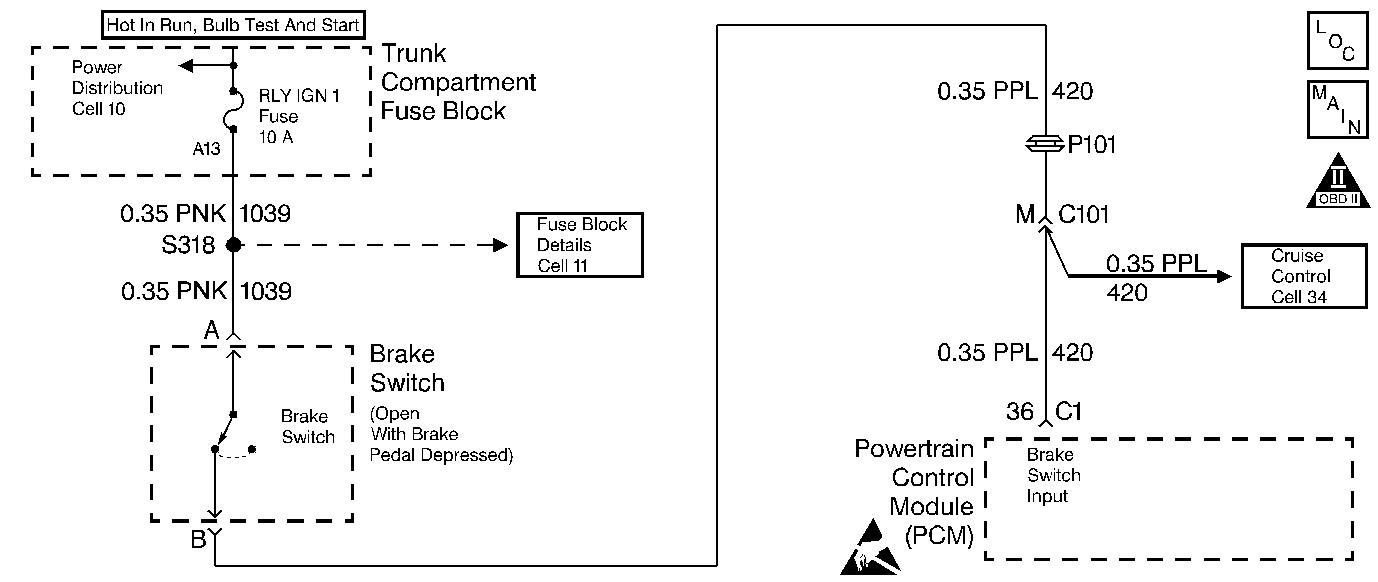
Circuit Description
The Torque Converter Clutch (TCC) brake switch is used to indicate the status of the brake pedal (applied or released).
When the PCM detects a status change on the brake lamp switch and the extended travel brake switch input without a transition on the TCC brake switch input, then DTC P0719 sets. DTC P0719 is a Type C DTC.
Conditions for Setting the DTC
| • | No VSS DTCs P0502 or P0503 are set. |
| • | No extended travel or stop lamp DTCs P1574 or P1575 are set. |
| • | No loss of PCM serial data P1602 is set. |
| • | The TCC brake switch input is at 0 volts. |
| • | Traction control or ABS is not active. |
| • | The difference in vehicle speed and a non-driven wheel speed is less than 10 km/h (6 mph). |
| • | The following conditions must occur 7 times within 15 minutes without a status change on the TCC brake input. |
| 1. | The vehicle speed is less than 8 km/h (5 mph). |
| 2. | The vehicle accelerates to 32 km/h (20 mph) taking longer than 2.5 seconds. |
| 3. | Then the vehicle speed remains above 32 km/h (20 mph) for 6 seconds. |
Action Taken When the DTC Sets
| • | SERVICE ELECTRICAL SYSTEM displays on the Driver Information Center (DIC). |
| • | The PCM uses the extended travel brake switch input or the stop lamp switch input for TCC control. |
| • | The PCM disables garage shift adapts. |
Conditions for Clearing the DIC/DTC
| • | The brake switch input must indicate voltage OFF for 2 seconds. |
| • | A scan tool can clear the DTC from the PCM history. The PCM clears the DTC from the PCM history if the vehicle completes 40 warm-up cycles without a failure reported. |
Diagnostic Aids
| • | Inspect the TCC brake switch for proper adjustment. |
| • | Check the customer's driving habits. |
| • | Inspect the wiring for poor electrical connections at the PCM. Inspect the wiring for poor electrical connections at the brake switch connector. Look for the following conditions: |
| - | A bent terminal |
| - | A backed out terminal |
| - | A damaged terminal |
| - | Poor terminal tension |
| - | A chafed wire |
| • | When diagnosing for an intermittent short to ground condition, massage the wiring harness while watching the test equipment for a change. |
Test Description
The numbers below refer to the step numbers on the diagnostic table.
-
This Step ensures that you perform the Powertrain On-Board Diagnostic System Check.
-
If the fuse is open, inspect circuit 1039, circuit 420, or circuit 847 for a short to ground. Circuit 847 is the input to the PCM from the extended travel brake switch.
-
This Step isolates the brake switch as the source for setting the DTC.
-
If the brake switch was adjusted properly, then replace the brake switch.
-
This Step inspects circuit 420 for an open, if the status on the scan tool never changed from released to applied. If an open is found, make the appropriate repair.
-
This Step replaces the PCM, after you have inspected the brake switch and all related circuitry.
Step | Action | Value(s) | Yes | No | ||||||
|---|---|---|---|---|---|---|---|---|---|---|
Was the Powertrain On-Board Diagnostic (OBD) System Check performed? | -- | Go to A Powertrain On Board Diagnostic (OBD) System Check | ||||||||
2 |
Important: Before clearing the DTCs, use the scan tool in order to record the Failure Records for reference. The Clear Info function will erase the data. Are DTCs 1574 or 1575 also set? | -- | ||||||||
3 |
Refer to Electrical Diagnosis, Section 8. Is the fuse open? | -- | -- | |||||||
Inspect the following circuits for a short to ground:
Refer to Electrical Diagnosis, Section 8. Did you find and correct the condition? | -- | -- | ||||||||
Does the brake status change from Applied to Released? | -- | |||||||||
Replace the Brake Switch. Refer to Brake Switch Replacement, Section 5. Is the replacement complete? | -- | -- | ||||||||
Inspect circuit 420 for an open. Refer to Electrical Diagnosis, Section 8. Did you find and correct the condition? | -- | |||||||||
Replace the PCM. Refer to PCM Replacement/Programming Section 6. Is the replacement complete? | -- | -- | ||||||||
9 | In order to verify your repair, perform the following procedure:
Has the test run and passed? | -- | System OK |
